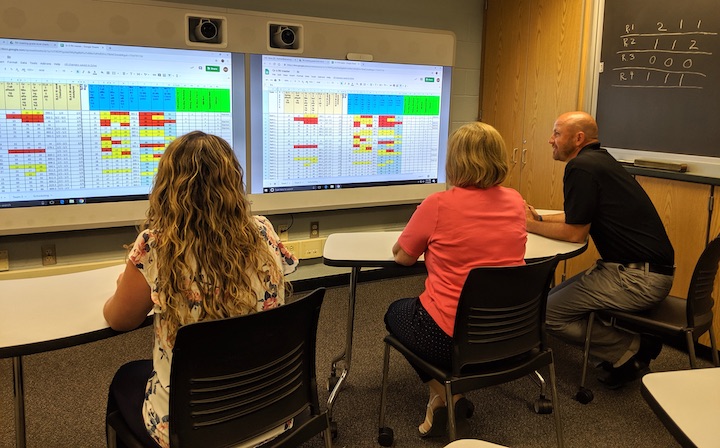7 Ways Our Data Buy-in Builds School Capacity
By Robert Messia and Joshua Gela
“Data-driven” is a buzzword in education that receives a lot of lip service. It has a very high priority among district administrators and researchers, but often isn’t fully embraced at the building level.
Data can be dismissed. It can be overwhelming. And it can even create anxiety. But despite its bad reputation, it can have incredibly positive impacts on student achievement and our educational system.
Over the past few years our school – Algonquin Middle in upstate Averill Park, NY – has made a conscious effort to improve our use of data to inform instruction and decision making for our students. Best of all, we have found some successful and relatively straightforward strategies to do so.
We know we are not alone in such work, nor are we on the cutting edge of utilizing data in every aspect of our school’s program. We are making headway with small action steps and initiatives that are benefiting our students.
Here are seven relatively easy ways to use data to build school capacity that have worked for us.
1. “Start With The Why”
British author and leadership guru Simon Sinek claims that when organizations make decisions and take actions they must “start with the why.”
That is, leaders need to establish the purpose, direction and underlying values of the decisions being made, clearly and explicitly. While educators in our district share the mission to “create opportunities for every student, every day,” there is a discrete Why? in each initiative that our schools undertake to support this work.
Defining that underlying “why” begins with a data vision statement. A collaboratively developed statement builds in staff ownership to start working with data more thoroughly.
At our school, our data vision statement is one sentence and goes like this:
“At AMS, we will utilize data-based decision making to objectively and flexibly promote the personal growth of all students, based on their whole child needs, focusing on academic success.”
This vision statement is only effective if school leaders integrate “the why” of data into each initiative and every gathering of faculty. Colleagues have different comfort levels with data. By starting with “the why,” a school leader helps staff focus on the purpose and importance of the topic at hand and how it relates to students and their learning.
2. Use Attendance Data
One of the most abundant data sources in schools are attendance records. At our school, our counselors and principals created an attendance monitoring group, where we meet every two weeks to look for patterns in student attendance and implement tiered interventions to promote student attendance.
To help articulate our goals, we have created Google Slides that are displayed in the hallways and on our student homepage showing average daily attendance for the building and grade levels with an established goal of 96% attendance for the year.
When a student’s attendance drops below 90%, their parents receive a letter that compares their child’s attendance to that of the average student in our school. In addition to the letter, counselors and administrators reach out to parents in order to open lines of communication and provide assistance.
If a student’s attendance rate drops to 85%, we put in place a “home-school connection” intervention that utilizes a grant-funded social worker to develop a tailored and comprehensive plan to support that student’s needs.
All of these efforts are driven by the clear data and a progressive plan to support students.
3. Regularly Share Current Course Grades
Student management systems have become incredibly powerful in recent years. Our system has the power to create an automatic report that pulls live student course averages from teacher gradebooks.
From this Excel export, we are able to send to teachers a snapshot of student achievement, with particular focus on students below 70% averages.
This is powerful for several reasons. First, teachers value their course grades and view them as their most fundamental measure of student achievement in their class.
Second, this creates a culture of shared accountability for student success, with homeroom and study hall teachers focusing their joint efforts on students who need additional support.
Above all, it helps students know that we are all committed to their success and keep open lines of communication around their achievement and progress.
4. Drive Student Goal Setting With Data
For those students who have demonstrated significant academic challenges, our school created an “Academic Goal Setting Group” that meets after school once a week.
During these meetings, students who earned grades of 65% or less in two or more courses in the previous marking period monitor their own progress. Students are asked at the beginning of each session to look up their current marking period average in our student management system and then enter those grades into a self-monitoring graph in Google Drive.
Students then review their assignments and grades to identify work that can then be completed and work on those assignments with the support of staff. Not only does this initiative help promote student achievement, it also deepens our relationship with families of our most struggling students. Parents have expressed appreciation that we are supporting their child and also helping to hold them accountable for their achievement through this program.
5. Analyze Assessments Collectively (and with Students)
In our school district, we place a strong value on a guaranteed and viable curriculum. Such emphasis has helped us develop common formative assessments utilizing a software program that allows for easy analysis of student results.
These assessments, developed by teachers of the courses, establish clear benchmarks for achievement and are easy to build using released state assessment questions. This year our school utilized a multidisciplinary scoring group to grade these assessments.

7th Graders at AMS participate in team building activities throughout the year. The culminating activity this year was a trip to Jiminy Peak’s Aerial Adventure Park.
As a result, teachers from math, social studies and literacy backgrounds, along with the building principals, developed a deeper understanding of student performance. The same group then developed a student reflection and self-regulation process, which had students apply a rubric to exemplars and their own assessments.
6. Increase the Power of Your Item Analysis
Two years ago, our seventh and eighth grade math teachers expressed an interest in looking more closely at their common quizzes and tests.
Teachers took their already aligned assessments and utilized a software product called DataMate to generate incredibly powerful item analyses. These reports give distractor analysis, standard achievement reports and even show individual student performance strengths over time.
As a result of our teachers’ use of this tool to make adjustments in their teaching methods, our program has experienced dramatic improvement in state assessment results.
Before fully utilizing this approach, our Grade 7 NYS Math Assessment Proficiency Rate was 31%, growing to 51% that next year. In Grade 8, our Proficiency Rate went from 9% to 37%.
This tremendous growth in student performance is a reflection on the hard work of our teachers and their willingness to effectively use data to support teaching and learning.
7. Have Data Lead a Tiered Intervention Placement Process
Each semester our grade level teams assemble to review student performance data in our Student Intervention Placement Meetings.
These 45-minute meetings are focused, collaborative discussions that start with numeric ranked student performance results from our most recent math and reading benchmarks and common formative assessment results, particularly for students below the 25th national percentile.
In these meetings teachers discuss student learning challenges, Tier 1 actions taken in classrooms to support these students and additional supplemental services that may be required to increase interventions. All student performance information is shared visually, and teachers can view the spreadsheets in advance.
An expansive spreadsheet (see above) displays various teacher-selected measures of student success and progress and helps focus our instructional interventions equitably and appropriately with the students who need them most.
Data-Driven to Succeed
Student achievement is a foundational goal in schools, and the effective use of data has the ability to help transform our schools to promote student learning.
Help your students achieve their potential and empower your colleagues to strengthen instructional practices by finding simple, straightforward and practical ways to make this happen.
____________________
Rob Messia became Principal of Algonquin Middle School in the Averill Park Central School District (NY) in 2011, after spending two years as A.P. and six years teaching seventh and eighth grade social studies. He worked for five summers with the Johns Hopkins Center for Talented Youth. Messia earned his B.A. in Social Studies Education from Siena College, a M.S. in Curriculum Development and Instructional Technology from the University at Albany, and a C.A.S. in Educational Leadership from the College of Saint Rose. Also see his 2017 MiddleWeb article, 8 Ways Middle Schools Can Build College/Career Readiness.
Josh Gela was appointed Assistant Principal of Algonquin Middle School in January 2016, after serving as a district-wide data coach. He has taught sixth grade social studies and spent eight years as a Fourth Grade teacher. Gela holds a B.A. in History, a M.S. in Curriculum and Instruction, and a C.A.S. in Educational Leadership, all from Massachusetts College of Liberal Arts.






































